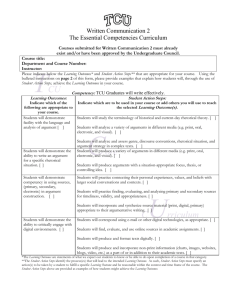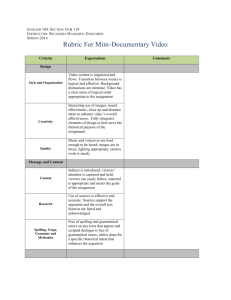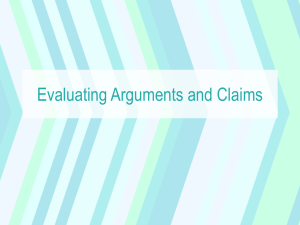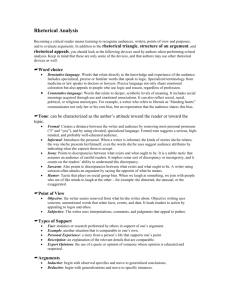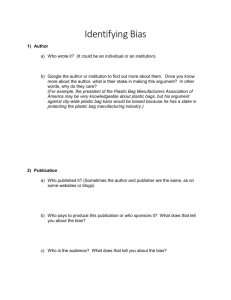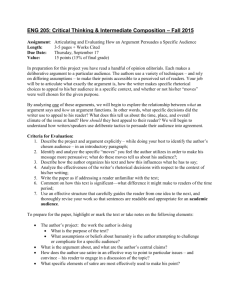Bias, Rhetorical Devices, and Argumentation
advertisement
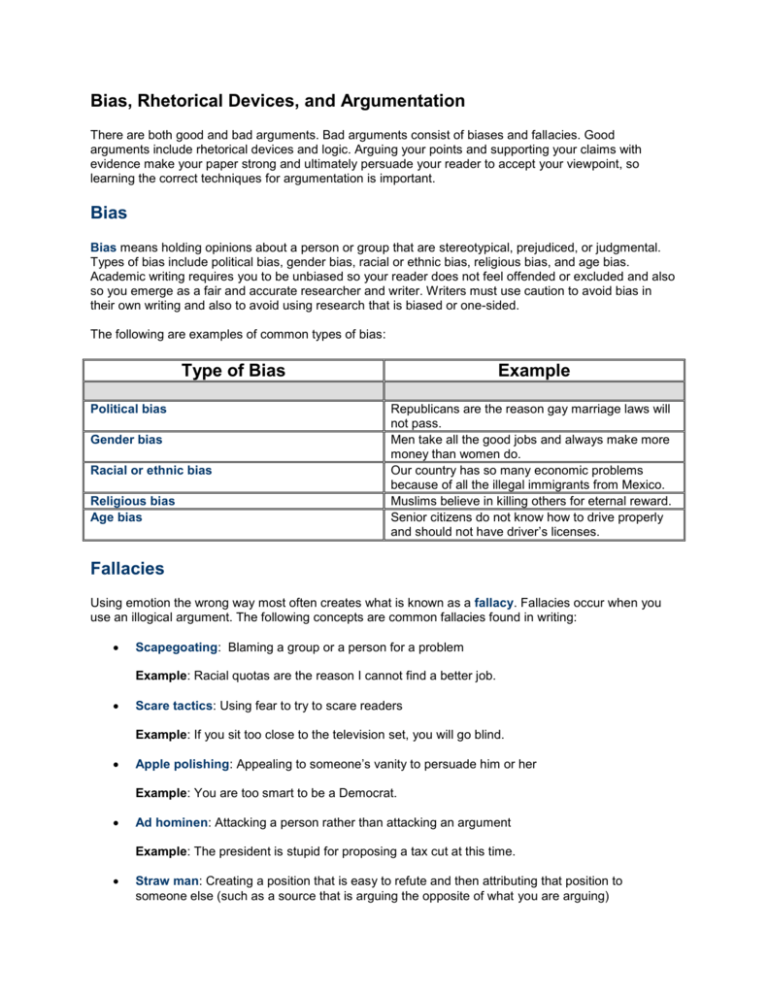
Bias, Rhetorical Devices, and Argumentation There are both good and bad arguments. Bad arguments consist of biases and fallacies. Good arguments include rhetorical devices and logic. Arguing your points and supporting your claims with evidence make your paper strong and ultimately persuade your reader to accept your viewpoint, so learning the correct techniques for argumentation is important. Bias Bias means holding opinions about a person or group that are stereotypical, prejudiced, or judgmental. Types of bias include political bias, gender bias, racial or ethnic bias, religious bias, and age bias. Academic writing requires you to be unbiased so your reader does not feel offended or excluded and also so you emerge as a fair and accurate researcher and writer. Writers must use caution to avoid bias in their own writing and also to avoid using research that is biased or one-sided. The following are examples of common types of bias: Type of Bias Political bias Gender bias Racial or ethnic bias Religious bias Age bias Example Republicans are the reason gay marriage laws will not pass. Men take all the good jobs and always make more money than women do. Our country has so many economic problems because of all the illegal immigrants from Mexico. Muslims believe in killing others for eternal reward. Senior citizens do not know how to drive properly and should not have driver’s licenses. Fallacies Using emotion the wrong way most often creates what is known as a fallacy. Fallacies occur when you use an illogical argument. The following concepts are common fallacies found in writing: Scapegoating: Blaming a group or a person for a problem Example: Racial quotas are the reason I cannot find a better job. Scare tactics: Using fear to try to scare readers Example: If you sit too close to the television set, you will go blind. Apple polishing: Appealing to someone’s vanity to persuade him or her Example: You are too smart to be a Democrat. Ad hominen: Attacking a person rather than attacking an argument Example: The president is stupid for proposing a tax cut at this time. Straw man: Creating a position that is easy to refute and then attributing that position to someone else (such as a source that is arguing the opposite of what you are arguing) Example: Person A’s argument: I do not think children should have a rigorous academic schedule all day. Person B’s misuse of Person’s A’s argument: You cannot allow children to play all day and not study. False dilemma: Presenting two choices as the only choices available when there are other options that have not been revealed Example: You are either for us or against us. Slippery slope: Suggesting an action will cause a chain of bad events Example: Once everyone owns a gun, no one will be safe. Begging the question: Circular reasoning in which a claim is given that suggests a conclusion Example: You are showing no remorse for the crime; therefore, you must be guilty. Rhetorical Devices Rhetorical devices are writing techniques designed to draw an emotional response from a reader. Using rhetorical devices in research writing can be highly effective because they: Add to the clarity of your writing. Enliven your writing. Help capture the reader’s interest. Restate important claims. The following are common types of rhetorical devices with definitions and examples: Alliteration: The same consonant sound repeated in a number of words in a sentence Example: "Somewhere at this very moment a child is being born in America. Let it be our cause to give that child a happy home, a healthy family, and a hopeful future." –William Clinton Hyperbole: An exaggeration Example: "The only place where democracy comes before work is in the dictionary." –Ralph Nader Euphemism: Replacing one expression with another that is more positive or agreeable in nature Examples: Restroom instead of toilet; correctional facility instead of prison; financial assistance instead of welfare Metaphor: Comparing two different things in the same sentence (without using the word like or as) Example: "With this faith we will be able to transform the jangling discords of our nation into a beautiful symphony of brotherhood." –Martin Luther King Parallelism: Sentences structured in a similar way to make it easier for the reader to understand Example: “Tell me and I forget. Teach me and I may remember. Involve me and I will learn.” – Benjamin Franklin Rhetorical question: Asking a question without expecting a response because the answer is obvious or implied Example: Are we having fun yet? Paradox: A figure of speech that is apparently contradictory but at the same time evokes some higher meaning Example: “I can resist everything except temptation.” –Oscar Wilde Rhetorical devices are considered nonargumentative forms of persuasion. Although useful, they should not be used to excess. The overuse of rhetorical devices leads to research writing that is diluted and distracting. Arguments and Counterarguments An argument in research writing is a case you make, along with support or reasons for the reader to believe the claim. When making an argument in research writing, your main objective is to assert something so strongly you are changing the way your reader feels about this subject. Keep in mind that an argument is not just an opinion or a feeling on its own; for example, saying, “I think capital punishment is wrong”. An argument is an opinion with reasons to support it and the aim to make others feel the same way. When you write arguments, try not to focus on whether or not your argument will convince the reader; instead, focus on supporting your claim with the strongest possible evidence. Structuring an Argument An argument should have a premise and a conclusion. The premise is the claim you make. Examples of words that indicate a premise are as follows: Because Given that A conclusion to a premise uses words such as the following: Therefore One can conclude Hence You must not only make a strong argument in research writing, but you must also successfully navigate counterarguments on the topic. A counterargument is an argument against another argument. When you write an argumentative essay, you must prepare for and address any potential counterarguments on your topic by shaping your essay to combat what the opposition might say. (If you are arguing against capital punishment, for example, it is important to address research that illustrates societal benefits of capital punishment.) As you research, look for opposing viewpoints, note those in your paper, and then find evidence to refute them. If the counterarguments contain biases or fallacies, for example, be sure to address them. Examples of Opposing Viewpoints The Thomson Gale PowerSearch database in the University Library contains a link to documents that present opposing viewpoints about a variety of issues. To access documents on your topic, follow the navigational directions below: 1. 2. 3. 4. 5. 6. Log onto your student Web site. From the My Learning Resources drop-down menu, select Tools & Tutorials. Click Library. Under Library Resources, select Article Database--Major. Then, click the Thomson Gale PowerSearch link. At the top right-hand side of the page, select Changing Databases (see screen shot below). 7. Then, click on Opposing Viewpoints Resource Center. 8. Select from the list of topics on the right side of the page, or enter keywords regarding your topic in the search box. For examples of opposing viewpoints on the issue of illegal immigration, review the following documents or listen to the audio files. As you read or listen to these opposing viewpoints, consider how the writers use rhetorical devices, arguments, and counterarguments in their articles. Note. You must be logged in to the Thomson Gale PowerSearch database at the University Library first. Then, copy and paste the URL into your browser to access the pages. Do Illegal Immigrants Burden the Justice System? http://www.npr.org/templates/story/story.php?storyId=5365863 Illegal Immigrant Cases Raise Issue of Jail Space http://www.npr.org/templates/story/story.php?storyId=7599133 DNA Sampling of Federal Detainees to Be Allowed http://www.npr.org/templates/story/story.php?storyId=7179926 Amid Rallies, Questions Over Immigrants' Impact http://www.npr.org/templates/story/story.php?storyId=5318377 Wrap-Up When writing, avoid illogical emotions as well as biases, fallacies, and any generalizations or judgments. Instead, use strong rhetorical devices and arguments supported by objective evidence. Sound arguments make your research paper effective. Even if your argument does not change your reader’s mind, you will have succeeded in presenting a claim with evidence to support it, which establishes you as a thorough and balanced and credible researcher.
![Program`s Dynamic Criteria Map (DCM)[1]](http://s3.studylib.net/store/data/007112770_1-0a2faad44b8e94d6ea99c5f4cbf00e83-300x300.png)
